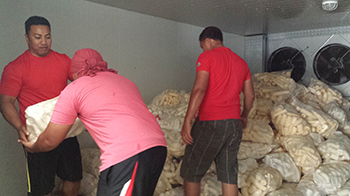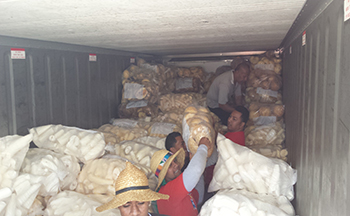Tongan and Samoan Members Assist Cyclone Victims in Vanuatu
Contributed By Jason Swensen, Church News staff writer

Saints of Tongatapu Tonga East Stake donated 56 bags of cooked breadfruits called cassiva. They are unloading them into the freezer container at the quarantine compound.
On March 14, a category-5 storm dubbed Cyclone Pam cut across the Pacific Island nation of Vanuatu. The disaster inflicted staggering damage. Countless families lost their homes and many others were left without food or water after high winds and rains destroyed their subsistence crops and scattered their belongings.
The First Presidency and the Presiding Bishopric acted immediately, working with the Pacific Area Presidency—shipping 1,500 tents, 2,000 food boxes, building supplies, and other provisions to impacted areas in an initial response to care for those in dire need.

Relief Society sisters in Samoa pack clothing that will be donated to people impacted by Vanuatu cyclone. Photo courtesy of the Pacific Area.

Samoan sisters pack bags with clothing that will be shipped to Vanuatu to assist folks impacted by cyclone. Photo courtesy of the Pacific Area.

Liahona stake brethren load up plastic bags of peeled cassava to be delivered to for final inspection in Tonga before being loaded into the freezer container.

Saints of Tongatapu Tonga East Stake donated 56 bags of cooked breadfruits. They are unloading them into the freezer container at the quarantine compound.

President Kupu (regional welfare committee chairman) is recording donations from all 14 Tongatapu stakes.

Two varieties of cassava—yellow type and white type—are loaded for shipment. Yellow is more popular to Tongans’ taste.

YSA brethren pack the freezer container all the way to the top.

Samoan members fill a shipping container with food bound for cyclone victims in Vanuatu. Photo courtesy of the Pacific Area.

Prince Ata seated in front with the local leaders standing behind him in front of the freezer container that is fully loaded and locked up ready to be shipped out to Vanuatu from Tonga.
But the relief effort didn’t end there. Members from the Polynesian countries of Samoa and Tonga have stepped forward to help, giving of their own substance to feed and clothe victims of the cyclone.
The people of Samoa and Tonga are culturally and linguistically different from the Vanuatuan people.
“But they consider each other cousins,” said Elder Kevin W. Pearson of the Seventy and president of the Pacific Area. “They love each other and share an empathy and compassion for one another.”
Latter-day Saints in Samoa and Tonga also have recent, first-hand experience with natural disasters.
In 2012, a tropical cyclone blasted the Samoan Islands, claiming more than a dozen lives and exacting hundreds of millions of dollars in damage.
And in early 2014, Cyclone Ian slammed the Tongan Islands. The massive storm destroyed hundreds of buildings and left thousands without homes.
In each of those disasters, impacted Latter-day Saints and their neighbors in Samoa and Tonga were the beneficiaries of relief assistance from members in the Pacific Area and across the globe. When the cyclone hit Vanuatu, the Tongan and Samoan members were anxious to provide help. Under the direction of the Pacific Area Presidency, stakes in Tonga and Samoa have worked together to collect food and clothing to be shipped to Vanuatu.
“We’ve been overwhelmed by the generosity of the Saints and their willingness to help one another,” said Elder Pearson. “The members there have said, ‘These are our brothers and sisters in our area, and we can contribute something.’ ”
Elder O. Vincent Haleck of the Seventy and first counselor in the area presidency has a professional background in the food industry in the Pacific. His expertise in shipping and logistics has proved invaluable in working with local shipping companies contracted to transport the donated goods to Vanuatu.
According to Elder Haleck, the Tongan and Samoan members have put together containers filled with food staples that are common to the Vanuatuan diet—including rice, canned mackerel, flour, sugar, and frozen breadfruit, along with tarot and other root crops.
Each bag of donated food or clothing represents a personal sacrifice.
“The members are giving of their own substance,” said Elder Pearson. “They are taking food they have grown for their own needs and giving it to those who have less.”
Such selfless service—offered under the direction of local priesthood leadership—epitomizes “the gospel in action,” said Elder S. Gifford Nielsen of the Seventy and second counselor in the Pacific Area Presidency.
“This is the principle of self-reliance,” he said. “We’re helping people get back on their feet so they can help someone else.”
Elder Nielsen also noted the capacity and devotion that have fueled the ongoing relief effort in Vanuatu. Priesthood and Relief Society leaders at all levels across the area have come together for a common effort.
“It’s been a total team effort,” he said.
Elder Haleck said the containers of food and provisions gathered by the Tongan and Samoan congregations will begin reaching Vanuatu, via sea, by the end of April.
“They are prepared to do more in both Samoa and Tonga and are awaiting further direction,” he said.
Elder Nielsen added that members in New Zealand and Australia are also contributing to the Vanuatu relief effort.
